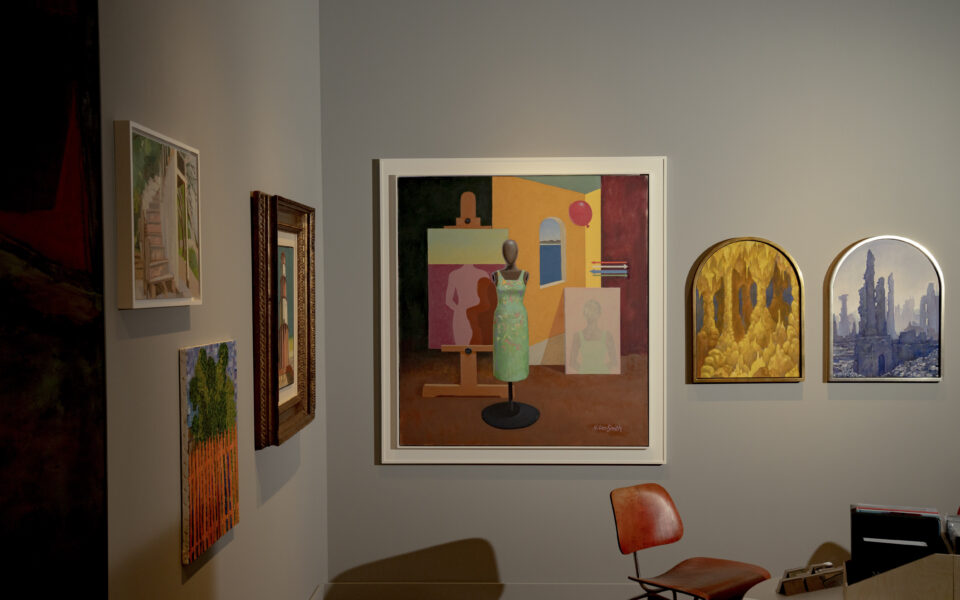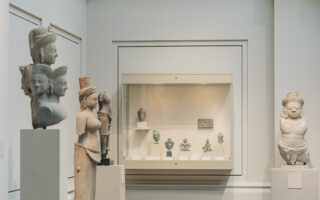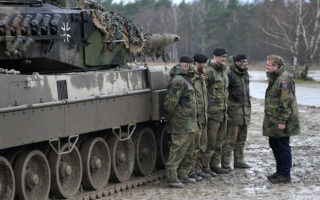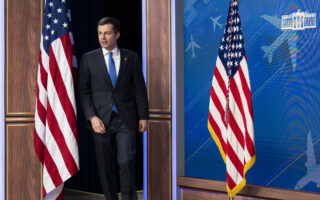TEFAF New York: A worldly fair overflows with art and design

NEW YORK – If you put the Metropolitan Museum of Art in a blender, you might end up with something like TEFAF New York. One of two annual fairs staged by the European Fine Art Foundation (the other is in Maastricht), it fills the historic Park Avenue Armory in Manhattan to its rafters this week with modern and contemporary art and design objects, even spilling into the hallways and up to the second floor.
This can make for entertaining juxtapositions inside the 1880 Gothic Revival building. This year, Friedman Benda gallery (Stand 101), one of nearly 100 exhibitors, is showing several colorful Ettore Sottsass vases under a permanently installed portrait of Wade Hampton Hayes, a brigadier general in the New York National Guard. Be prepared for a deluge of furniture, jewelry, art and antiquities spanning several millenniums, often in a single booth.
If you decide to shell out the $55 it costs to get in, I recommend taking a scavenger-hunt approach and thinking in terms of individual pieces. “Models with Model Ship” by Philip Pearlstein, shown along with strong works by Michael Ray Charles and Omar Ba at Templon (326), is an object worth looking for, as are the Fernand Léger at Robilant+Voena (103) and a pair of incredible NC Wyeth seascape murals – one with additional work by his son Andrew – at Bernard Goldberg Fine Arts LLC (357), which is also showing two monumental Winold Reiss art deco murals rediscovered from the Empire State Building.
A powdery green bronze and copper mirror by Claude Lalanne at Galerie Lefebvre (209) would be the star of any bedroom, as would a midcentury “crocodile cabinet” at Dansk Møbelkunst Gallery (320). And before you leave, make sure to compare found poster art at Edward Tyler Nahem by Italian artist Mimmo Rotella (321) with a very similar piece by Jacques Villeglé at Galerie Georges-Philippe & Nathalie Vallois (358) – and to count how many times Mel Bochner writes “blah blah blah” on a small ink on paper text piece at Peter Freeman, Inc (306).
Meanwhile some whole booths did stand out from the crowd; below are my top nine.
Pace (301) and David Zwirner (347)
You can always count on megagalleries to show up with strong solo presentations. In this case, Pace Gallery leads off the fair with a spread of abstract collages, from the ’50s to the ’80s, by Louise Nevelson; directly cater-corner is Zwirner’s minimal display of 1940s-’50s paintings from Josef Albers’s “Variant/Adobe” series. Nevelson’s collages, which combine cardboard scraps with paper, metallic tape and wood, have an entrancing dissonance. Her almost fussy arrangement can never quite subordinate the cardboard’s rough edges. Albers’ horizontal rectangles impart an otherworldly serenity, but are enlivened by dynamic pairs of vertical dashes which sometimes look disconcertingly like cartoon eyes. (And right across the way, at Gagosian (350), Jeff Koons stares earnestly across the naked chest of his former wife Cicciolina in his contrasting 1990 piece.)
Karma (307) and Demisch Danant (360)
These galleries make everything-but-the-kitchen-sink art fair booths into coherent exhibitions. Karma offers a deep bench of paintings with an architectural theme: A 1966 tower by Giorgio de Chirico, which seems to loom over tiny figures, is an unnerving portrait of psychological ambivalence, while Lynn Drexler’s painting of a tree hiding behind its bright orange fence could be a metaphorical homage to parental self-effacement. Two aisles over, the design gallery Demisch Danant furnishes its booth like a tasteful home with powerful Sheila Hicks wall textiles, a sexy red lacquer console by Maria Pergay and Noé Duchaufour-Lawrance’s 2021 “Burnt Cork Chair.”
W& K-Wienerroither & Kohlbacher (308)
Naked people cavort in Franz West collages from the ’80s and ’90s in this Viennese gallery’s display, but most of its interesting nudes were composed earlier in the century by German expressionists and other boldface names (Ernst Ludwig Kirchner, Joan Miró). My favorite piece in the booth, if not in the whole fair, was an Egon Schiele drawing of a reclining woman. Enclosing one broad thigh with his masterful black line, the Austrian prodigy transformed rough brown paper into immortally creamy flesh.
Hazlitt Holland-Hibbert (311)
Dark gray walls and a sisal carpet make the perfect setting for early-2000s works by the English hard-edge painter Bridget Riley, all featuring her signature rolling, serif-like waves of lucid color. Glossy and imposing in oil, these waves look very different in a rarely seen, 6-by-9-foot gouache cartoon. Make sure you get close enough to see the charming question Riley left to herself, penciled on one side: “Should this shape be blue?”
Thaddaeus Ropac (344)
The 83-year-old Viennese painter Martha Jungwirth works on huge sheets of craft paper or tranches of used cardboard, marking each pale brown expanse with a few expressive, muddy red strokes. It’s a dramatic metaphor for the human condition, with its incongruous marriage of spiritual longing and all too mortal flesh. Visually it’s even more striking: While Jungwirth’s paint brings out the pinstripe elegance of corrugation or the accidental delicacy of smudges and oil stains, those same workaday details give her gestures a vitality you’d be hard-pressed to find on gessoed canvas.
Petzel (370)
Cuban American artist Jorge Pardo stretches the boundary between art and design, but it never quite breaks. A latticework bar constructed of router-cut wood and translucent red panels, relocated from Pardo’s Los Angeles studio building, anchors the booth along with his signature light fixtures. But a pair of bumpy new abstract wall works in acrylic and colored pencil are deceptive. Take the time to notice their bizarre intricacy: They look like scientific samples from some extraterrestrial lizard hunt.
The Mayor Gallery (375)
Verena Loewensberg (1912-1986) studied design, color theory, choreography, dance and weaving in Basel, and was deeply influenced by visits to Paris. But most of her art life took place in Zurich, where she painted the five deeply unusual geometric compositions in this booth. Thin lines of purple and blue divide larger blocks of green and gray in one untitled canvas from 1978 – it feels like chasing a mirage under moonlight.
TEFAF New York Art Fair
Friday-Tuesday, May 12-16, at Park Avenue Armory in Manhattan; tefaf.com.
This article originally appeared in The New York Times.






